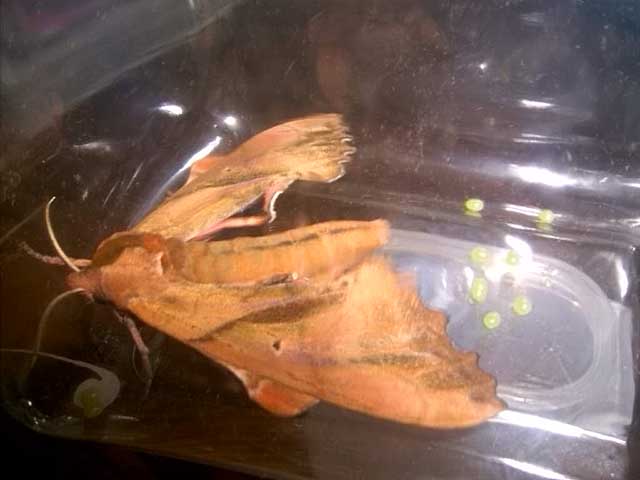Lake County, California
Sphingidae

|
|
Created/dedicated as per personal communication with K. G., July 27, 2011 Updated as per James P. Tuttle's The Hawk Moths of North America, July 27, 2011 |

C. G. writes, "Hi how are you? My son found a really nice Sphinx Moth that he named Mothra. We have it in a large spice jar that has holes in the lid for air. We kept it outside last night and found that it laid eggs. What do we do now?
"My son wants to watch the eggs become pupae, then eventually hatch. What do we do to make this happen?
"The eggs are just lying in the bottom of the jar, do we just leave them there, will they become pupae just like they are or do we need to do something else? Right now the jar is the house at room temp. See attached photo's. Thank you, I hope you can help us!"
I reply: "Hi K. G.,"The eggs will probably hatch about 8-11 days (sooner if kept warm) from when they were deposited. Then the caterpillars will eat for about 4-5 weeks before it is time for them to pupate. You can read an article I put together about rearing luna moths and these eggs and larvae can be treated pretty much the same way: http://www.silkmoths.bizland.com/Actiaslunarearing.htm
"You should also read the article at http://www.silkmoths.bizland.com/eggcare.htm.
I suggest that you probably have plenty of eggs already, more than you or he really want to look after, so it would be a good idea to release the moth after dark this evening.
"It is Paonias excaecata, the Blinded Sphinx.
Please also read the accounts of my rearing of both Paonias excacata and Smerinthus cerisyi via the links on this page." It is hoped that this checklist, with the thumbnails and notes, will help you quickly identify the moths you have encountered.
Please help me develop this list with improved, documented accuracy by sending sightings (species, date, location), preferably with an image, via email to Bill Oehlke.
Sphinginae subfamily
Smerinthini Tribe:
Macroglossinae subfamilyDilophonotini Tribe:
Philampelini Tribe:
Macroglossini Tribe:
|
Use your browser "Back" button to return to the previous page.
This page is brought to you by Bill Oehlke and the WLSS. Pages are on space rented from Bizland. If you would like to become a "Patron of the Sphingidae Site", contact Bill.
Please send sightings/images to Bill. I will do my best to respond to requests for identification help.
 Show appreciation for this site by clicking on flashing butterfly to the left. The link will take you to a page with links to many insect sites. |